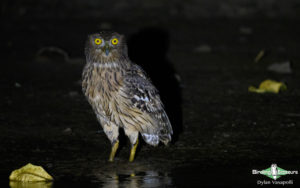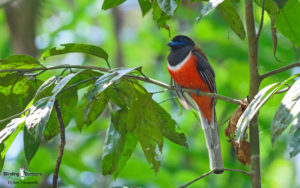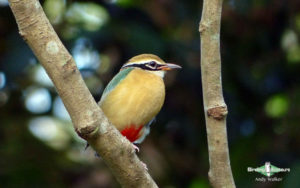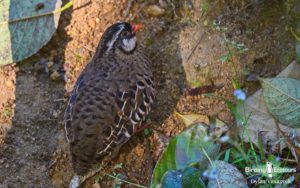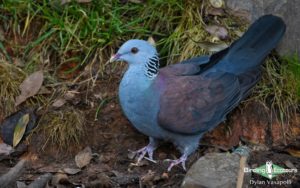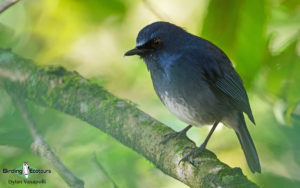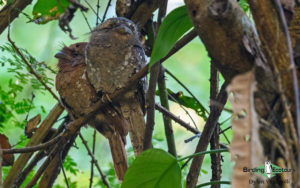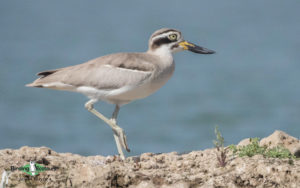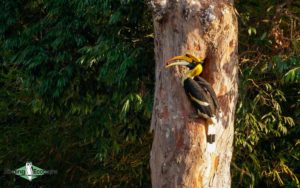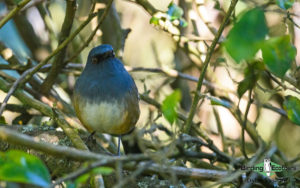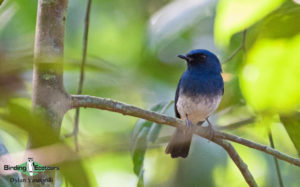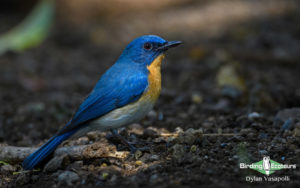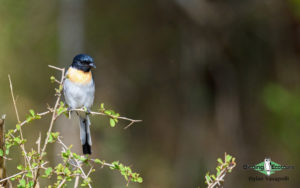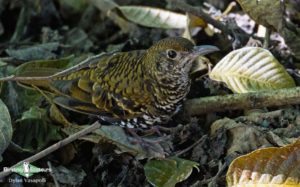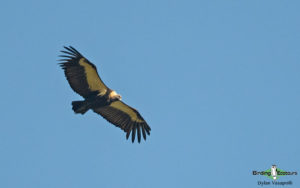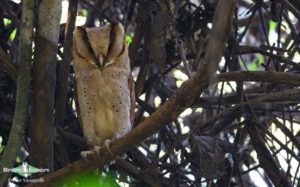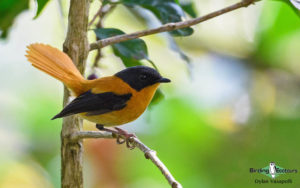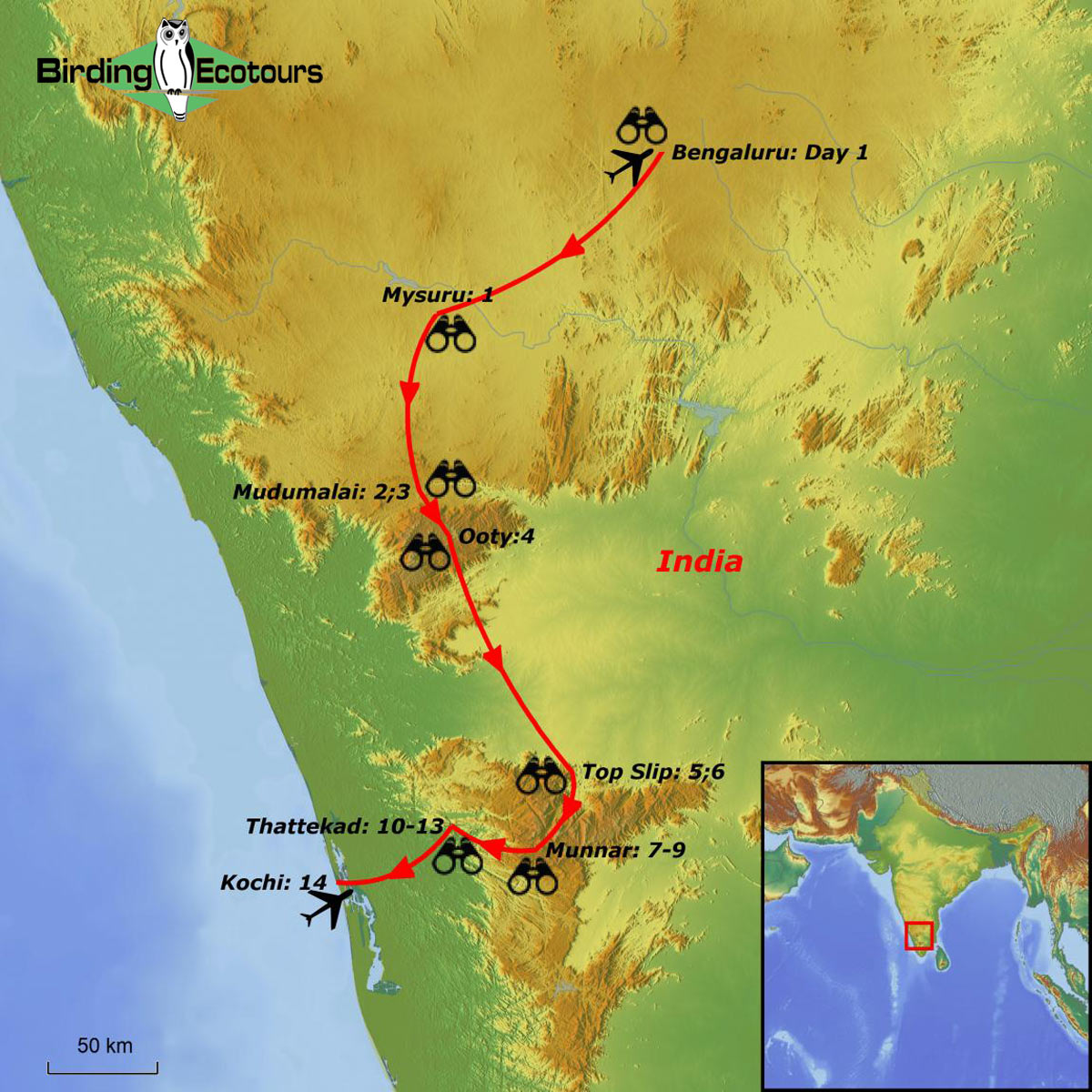Birding Tour India: The South – Western Ghats and Nilgiri Endemics
Go to: India Birding Tours | Birding Tours in Asia | All our birding tours
Birding Tour India: The South – Western Ghats and Nilgiri Endemics,
January 2026
This two-week tour will focus on the many specialties that southern India has to offer in a small-group atmosphere, perfect for the forested environments we will bird in. The tour commences on the coast at Kochi (also known as Cochin), a large sea-port city in the state of Kerala and an ancient city of high value on the old spice-trading route, and finishes at the city of Bengaluru (formerly Bangalore), the capital of the state of Karnataka. Our journey will take in the vast splendor of the Western Ghats and Nilgiri Hills, where we will also enjoy a steady stream of Western Ghats and Nilgiri endemic birds and other wildlife as well as an excellent supporting cast of overwintering migrants and resident birds.
The delightful Indian Scimitar Babbler.
Some highlights on this tour are likely to include Black-and-orange Flycatcher, Indian Blue Robin, Nilgiri Blue Robin, White-bellied Blue Robin, Nilgiri Thrush, Nilgiri Laughingthrush, Palani Laughingthrush, Wayanad Laughingthrush (formerly called Wynaad Laughingthrush), White-bellied Treepie, Malabar Woodshrike, Malabar Barbet, Nilgiri Wood Pigeon, Nilgiri Flycatcher, Nilgiri Pipit, Sri Lanka Bay Owl, Malabar Whistling Thrush, Blue-winged (Malabar) Parakeet, Malabar Grey Hornbill, Malabar Trogon, Sri Lanka Frogmouth, Indian Pitta, Painted Bush Quail, Red Spurfowl, Great Eared Nightjar, White-bellied Minivet, and, with luck, Indian Vulture and White-rumped Vulture (both Critically Endangered IUCN) and the rare migrant Kashmir Flycatcher.
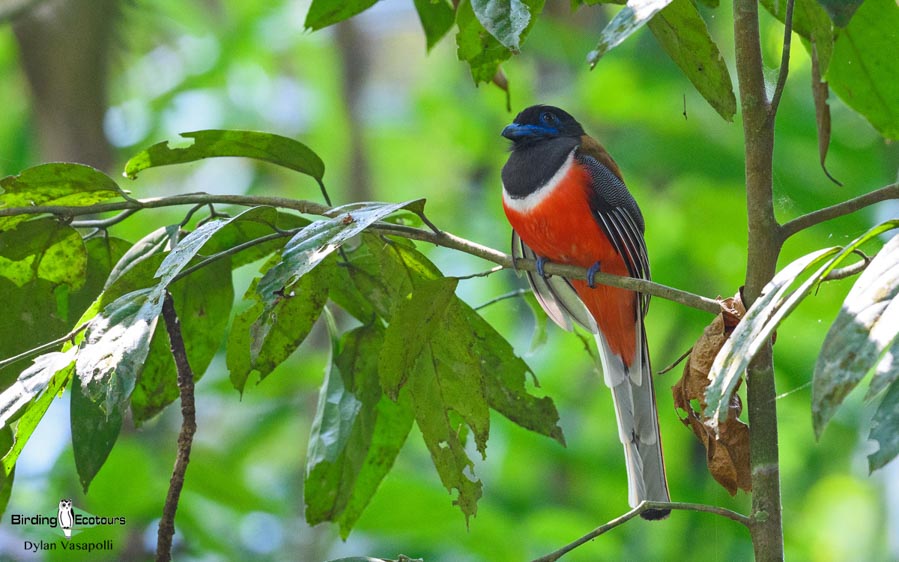
During the tour we will visit some very exciting nature reserves and sanctuaries, such as Ranganathittu Bird Sanctuary, Chinnar Wildlife Sanctuary, and, most famous of all, Thattekad Bird Sanctuary (probably one of the best birdwatching sites in southern India and an incredible place to start this tour). We will also visit some rather nice colonial hill stations, reminiscent of many countries formerly part of the British Empire such as in Kenya, Malaysia, and Sri Lanka. Interestingly, these locations (chosen for their cooler climate than that of the lowlands) often offer access to wonderful higher-elevation birding sites. They also often provide an interesting window into the cultural history of the area. Southern India is also very exciting in terms of food, which is considered rather different from that of other areas of India and promises to be memorable.
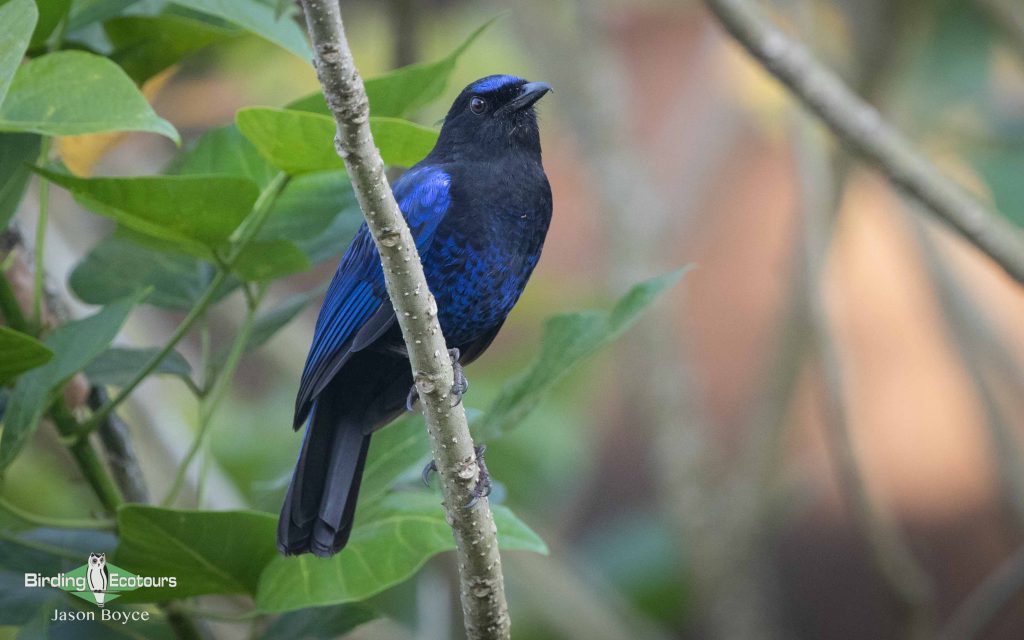
You can continue after this tour with our Birding Tour India: Andaman Islands Endemics, designed specially to follow and complement this Southern India tour. The Andaman trip will look for numerous endemic birds, such as Andaman Woodpecker, Andaman Nightjar, Andaman Crake, Andaman Serpent Eagle, Andaman Masked Owl, Andaman Treepie, and many more! We also have many other exciting and extensive Indian tours following after this one; details of these can be found here.
We can also easily offer you birding, wildlife-watching, or cultural extensions at each location if you would like to extend your stay in this wonderful, diverse, and vibrant country.
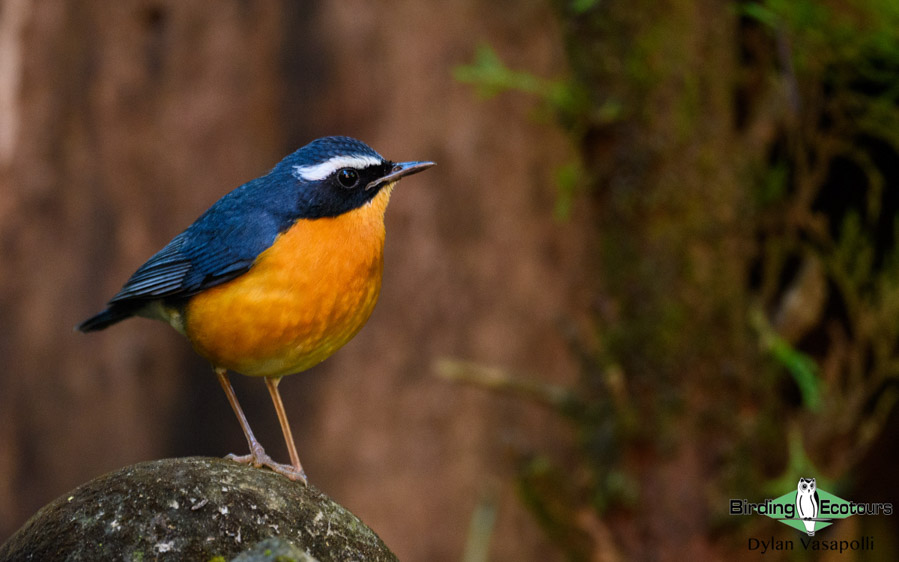
Itinerary (15 days/14 nights)
Day 1. Arrival in Kochi (Cochin), birding nearby and transfer to Thattekad
After your morning arrival in Kochi (Cochin) we will all meet for a welcome lunch in a local restaurant. After lunch we will spend some time looking for wading birds and shorebirds nearby. This area is usually heaving with birds, and we may find Asian Openbill, Wood Sandpiper, Little Ringed Plover, Black-winged Stilt, Ruff, Marsh Sandpiper, Temminck’s Stint, and Little Stint among others before we transfer to our hotel in Thattekad, where we will spend the next three nights as we explore this wonderful area.
Overnight: Thattekad
Days 2 – 3. Thattekad Bird Sanctuary
Thattekad Bird Sanctuary is the prime birding destination in Southern India. We will have two full days and nights to thoroughly explore and enjoy the sanctuary and the superb surrounding local area, and this is a fantastic location to commence our southern Indian birding in earnest.
Diurnal and nocturnal specialties here are many and include Indian Pitta, Grey Junglefowl, Flame-throated Bulbul, Grey-headed Bulbul, White-bellied Treepie, Malabar Woodshrike, Sri Lanka Frogmouth, Malabar Trogon, Red Spurfowl, Indian Swiftlet, Jungle Owlet, Sri Lanka Bay Owl, Spot-bellied Eagle-Owl, Rufous Babbler, Orange Minivet, Blue-faced Malkoha, Brown-breasted Flycatcher, White-bellied Blue Flycatcher, Rusty-tailed Flycatcher, Malabar Starling, Asian Fairy-bluebird, Loten’s Sunbird, Black-hooded Oriole, Common Emerald Dove, Black-rumped Flameback, and Thick-billed Warbler.
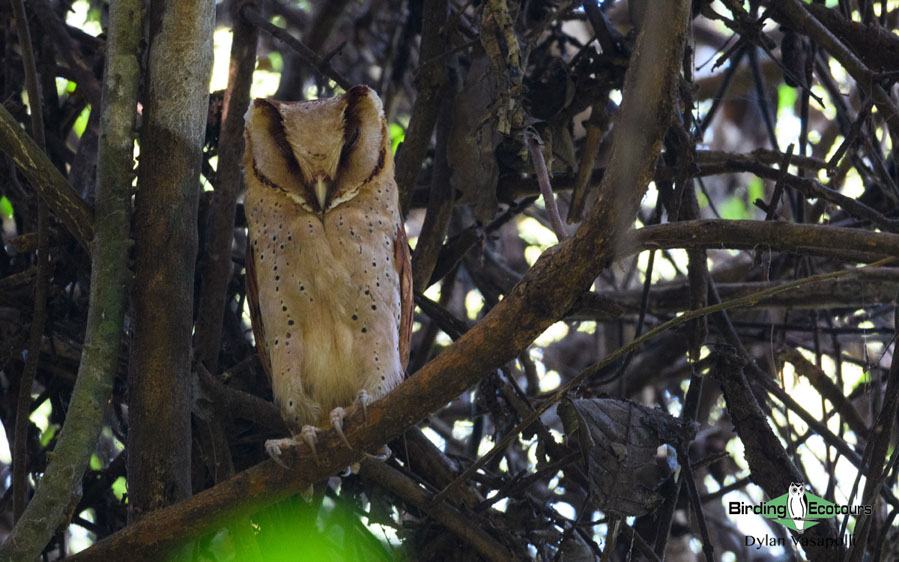
A few of the other species we will spend time concentrating on in Thattekad will be Malabar Grey Hornbill, Malabar Whistling Thrush, Blue-bearded Bee-eater, Black-throated Munia, and Brown Hawk-Owl. As we search for the above we are likely to find the following more widespread (but equally impressive) species: Indian Paradise Flycatcher, Lesser Yellownape, Heart-spotted Woodpecker, White-bellied Woodpecker, Fork-tailed Drongo-Cuckoo, Crested Goshawk, Mountain Imperial Pigeon, Plum-headed Parakeet, White-rumped Spinetail, Lesser Fish Eagle, Oriental Dollarbird, Brahminy Kite, Indian Golden Oriole, and Black-naped Monarch. The stunning Black Baza, probably one of the best and most unique-looking raptors in the world, is possible here, as is the spectacular Great Hornbill. The hornbill is actually one of the most important seed-spreaders in the Western Ghats and is responsible for distributing seeds far and wide from over 40 tree species!
We will concentrate our efforts on the morning and afternoon sessions, and if local conditions allow during the late afternoon we will visit a small water puddle that sometimes produces some good-looking passerine species, including Indian Blue Robin, White-bellied Blue Flycatcher, Tickell’s Blue Flycatcher, Puff-throated Babbler, and Orange-headed Thrush. Brown-breasted Flycatcher, Malabar Trogon, and Blue-winged Parakeet also occur here, and we will be looking for them.
We will also take some night drives/walks with the aim of connecting with a few of the incredible (and tough) night birds on offer, such as those listed already above plus Great Eared Nightjar, Jerdon’s Nightjar, Indian Nightjar, Savanna Nightjar, and Eastern Barn Owl.
Overnight: Thattekad
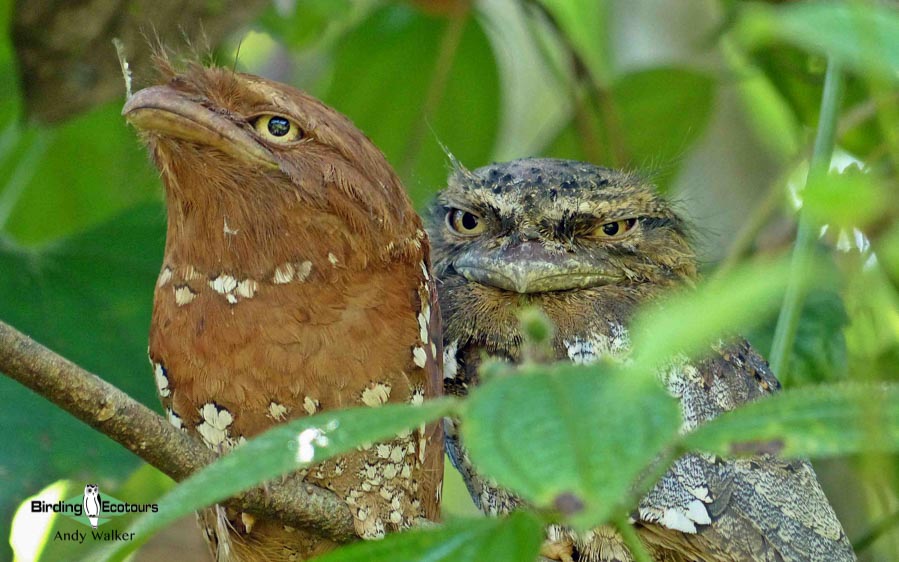
Day 4. Thattekad to Periyar
After a final morning birding in Thattekad we will move to Periyar, ready to spend the full day there tomorrow looking for our target birds. We will have an afternoon walk to get started on some of the birds listed for day 5, including our main target of the area, Wayanad Laughingthrush (formerly called Wynaad Laughingthrush).
Overnight: Periyar
Day 5. Periyar
Our main target bird in Periyar is the endemic Wayanad Laughingthrush. Although this Western Ghats endemic species is relatively widespread in suitable moist forest it is probably one of the tougher birds to see due to its habit of quickly moving around in the undergrowth, it is a bit of a skulker! Other species we might see include Malabar Grey Hornbill, Nilgiri Wood Pigeon, Blue-winged (Malabar) Parakeet, Great Hornbill, Black Baza, Nilgiri Thrush, Nilgiri Flycatcher, White-bellied Blue Flycatcher, Little Spiderhunter, and Crimson-backed Sunbird.
Overnight: Periyar
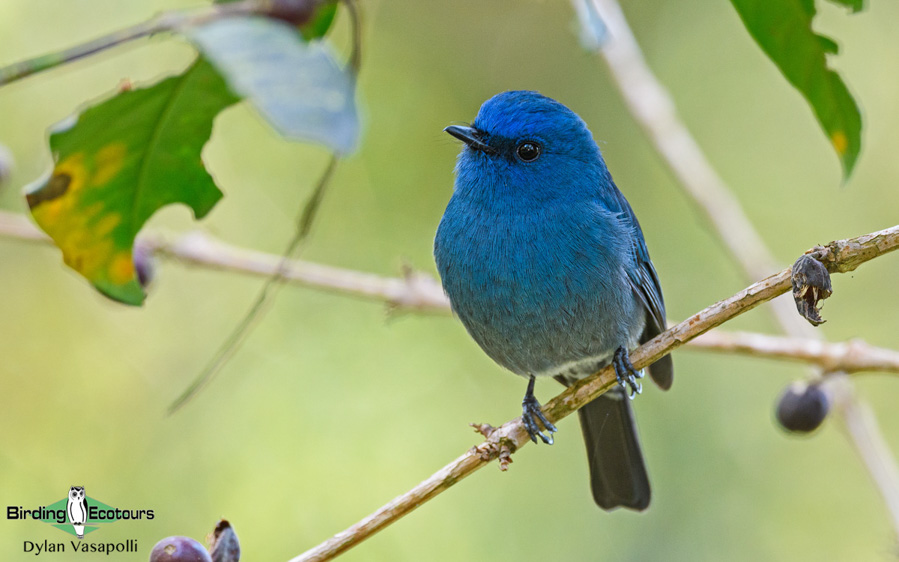
Day 6. Periyar to Munnar
After a final morning birding in the Periyar area we will continue to our next base at Munnar. The forests and montane grassland in the Munnar area are home to numerous southern specialties, and we will spend the remainder of the afternoon (if time) and the whole of the following two days looking for these. We will also look for Nilgiri Tahr, an endemic and Endangered (IUCN) ibex found high in the mountains of the Western Ghats.
Overnight: Munnar
Days 7 – 8. Munnar area and Eravikulam National Park
There are a lot of high-quality birds at Munnar and the surrounding area including the magnificent Eravikulam National Park. We will spend two full days looking for the following key target species from this region: Palani Laughingthrush, Nilgiri Thrush, Nilgiri Pipit, Painted Bush Quail, White-bellied Blue Robin, Broad-tailed Grassbird (present but tough at this time of year – try our Birding Tour India: – Rajasthan Monsoon Specialties for a range of birds that are easier in the monsoon), Nilgiri Wood Pigeon, Crimson-backed Sunbird, Nilgiri Flycatcher, Malabar Whistling Thrush, Indian Scimitar Babbler, Yellow-browed Bulbul, Yellow-throated Bulbul, Grey-fronted Green Pigeon, Malabar Barbet, Little Spiderhunter, Brown-cheeked Fulvetta, Vernal Hanging Parrot, Rusty-tailed Flycatcher, Indian Blackbird, Hill Swallow, and Blue-capped Rock Thrush. There will be much more to see beyond this small sample of birds listed.
Overnight: Munnar
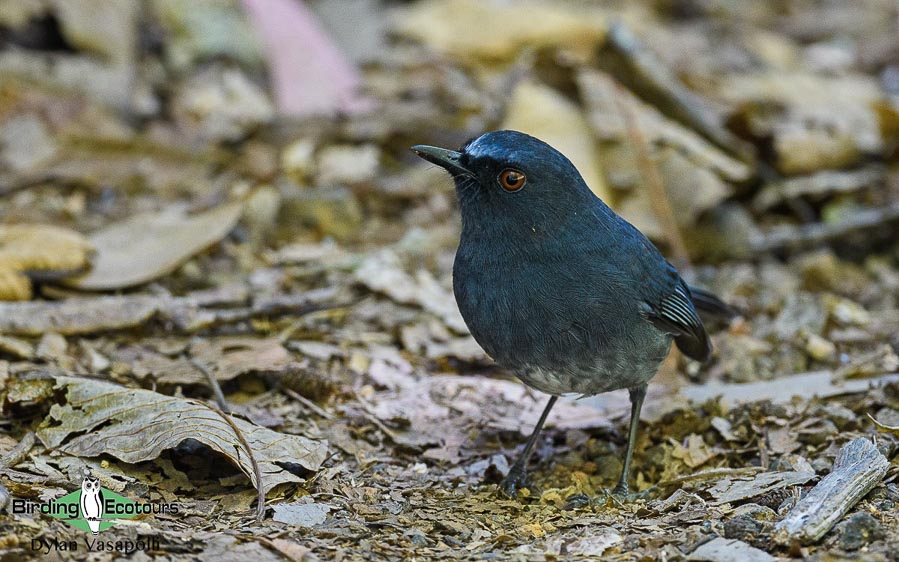
Day 9. Munnar to Chinnar Wildlife Sanctuary
After a final morning around Munnar, probably exploring the great area around our accommodation, we will continue our journey to Chinnar Wildlife Sanctuary. During our afternoon birding we will try to find the huge (and rather spectacular, yet very secretive) Spot-bellied Eagle-Owl. While looking for the owl we may also find Malabar Whistling Thrush, Brown Fish Owl, Western Crowned Warbler, and Tickell’s Blue Flycatcher. We will also keep an eye in the trees for Sri Lankan (Grizzled) Giant Squirrel – a huge squirrel!
Overnight: Chinnar
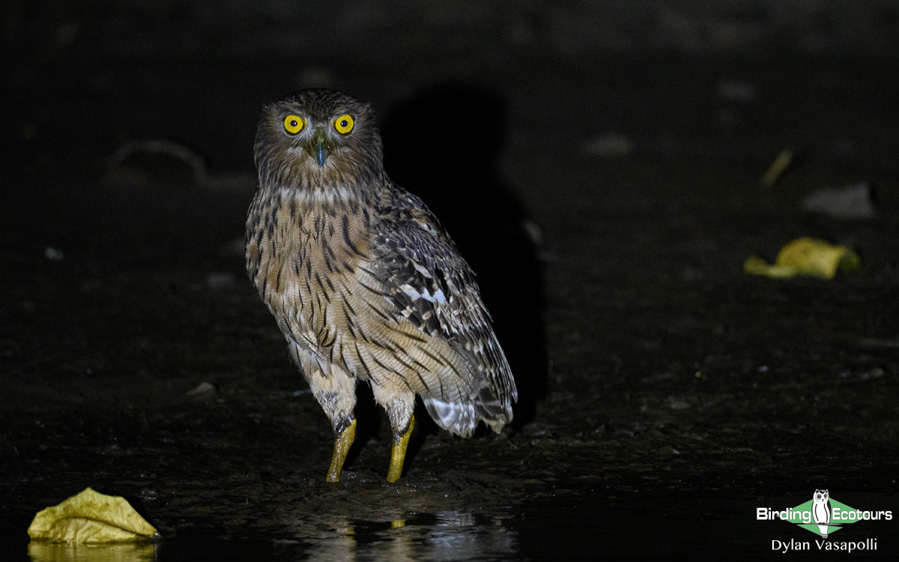
Day 10. Chinnar to Ooty
Following an early-morning birding session in Chinnar we will commence our journey to the old colonial British hill station of Ooty at about 2,200 meters (7,200 feet). Our first stop is likely to be a local hotel, where we will search for Black-and-orange Flycatcher, Indian Blue Robin, and Nilgiri Laughingthrush – all three are beautiful birds. Once we have had our fill here we will spend the remainder of the day checking out patches of shola forest, where there are many of our trip target birds to be found; some of these include Nilgiri Blue Robin, Nilgiri Thrush, Malabar Whistling Thrush, Indian Blackbird, Jerdon’s Leafbird, Yellow-browed Bulbul, Malabar Barbet, Nilgiri Wood Pigeon, Hill Swallow, and Painted Bush Quail. Other more-widespread species we may discover during the day could be Vernal Hanging Parrot, Black Eagle, Square-tailed Bulbul, and Bar-winged Flycatcher-shrike. If we are very lucky we may even find a rare overwintering migrant such as Kashmir Flycatcher.
Overnight: Ooty
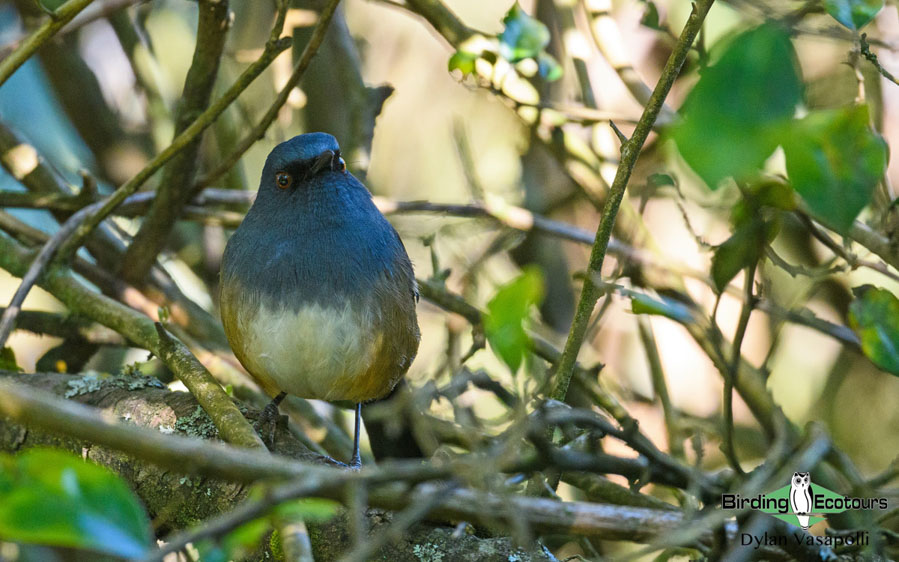
Day 11. Ooty to Mudumalai
After a final morning birding around Ooty, looking for the species listed for day 10, we will drop down to Mudumalai, making a start on the birds listed for day 12.
Overnight: Mudumalai
Day 12. Mudumalai
We will have the full day exploring the scrub habitat around the Mudumalai area and will have a morning and afternoon birding session looking for a range of target birds. The middle of the day will be spent relaxing in our attractive hotel grounds. We will seek the following species during our birding sessions (and many more): Jungle Bush Quail, Grey Junglefowl, Indian Peafowl, Red Spurfowl, Indian Vulture, White-rumped Vulture, Spot-bellied Eagle-Owl, Brown Fish Owl, Yellow-wattled Lapwing, Indian Nightjar, Indian Pitta, Blue-faced Malkoha, Blue-winged (Malabar) Parakeet, Common Hawk-Cuckoo, Yellow-crowned Woodpecker, Heart-spotted Woodpecker, Streak-throated Woodpecker, Ashy-crowned Sparrow-Lark, Jerdon’s Bush Lark, Malabar Lark, Indian Nuthatch, Black-headed Cuckooshrike, Yellow-billed Babbler, White-browed Bulbul, White-bellied Minivet, Small Minivet, Hume’s Whitethroat, Booted Warbler, White-cheeked Barbet, Orange-headed Thrush, Nilgiri Flowerpecker, and the gorgeous Red Avadavat.
Overnight: Mudumalai
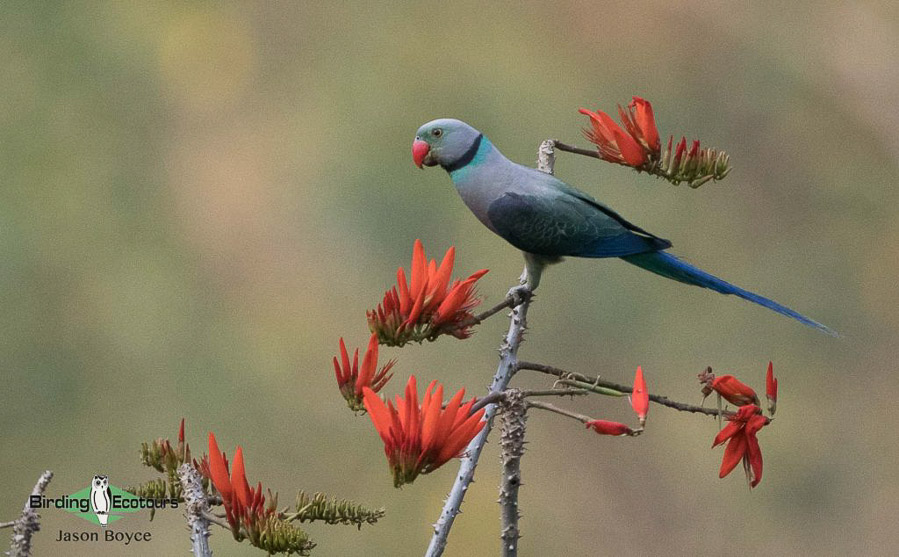
Day 13. Mudumalai to Mysuru (Mysore)
The morning will be spent in the marvelous Mudumalai area looking for any remaining targets listed for day 12. After lunch we will leave our wonderful hotel behind as we travel to Mysuru (Mysore), stopping along the way at several sites that may yield a few interesting species such as Blue-winged (Malabar) Parakeet, Red-naped Ibis, Yellow-wattled Lapwing, and Small Pratincole.
Overnight: Mysuru (Mysore)
Day 14. Mysuru (Mysore) to Bengaluru (Bangalore)
We will start the final full day of the tour birding at Ranganathittu Bird Sanctuary, where we will take a boat trip along the Cauvery (Kaveri) River. This small park is packed full of birds and offers some great photo opportunities of many, a perfect way to end the tour. During the boat trip we could see Spot-billed Pelican, Streak-throated Swallow, White-spotted Fantail, River Tern, and Indian Eagle-Owl. We are also likely to get some great views of Painted and Woolly-necked Storks. After finishing our birding in the sanctuary we will continue our journey to Bengaluru (Bangalore). Along the way we will stop at an area that is good for viewing Indian Vulture and occasionally White-rumped Vultures, both of these species are Critically Endangered (IUCN) and could certainly end our tour off in style!
We will have a final group evening meal together at our very comfortable hotel near the airport, where we will enjoy some great food and discuss what our “bird of the trip” might be.
Overnight: Bengaluru (Bangalore)
Day 15. Departure from Bengaluru (Bangalore)
Non-birding day. The tour concludes with international departure from Bengaluru (Bangalore). However, if you would like to continue your birding adventure you could join our Birding Tour India: Andaman Islands Endemics for a range of endemic species found only on the Andaman Islands, or our Birding Tour India: The North – Tigers, Amazing Birds, and the Himalayas, where we look for Bengal Tiger and some incredible birds such as the monotypic pair of Ibisbill and Wallcreeper and a great deal of other exciting birds such as Cheer Pheasant, Indian Courser, and Indian Skimmer.
Overnight: Not included
Please note that the itinerary cannot be guaranteed as it is only a rough guide and can be changed (usually slightly) due to factors such as availability of accommodation, updated information on the state of accommodation, roads, or birding sites, the discretion of the guides and other factors. In addition, we sometimes have to use a different international guide from the one advertised due to tour scheduling.
Download ItinerarySouth India: Western Ghats Trip Report
12 – 25 JANUARY 2020
By Dylan Vasapolli
DOWNLOAD TRIP REPORT
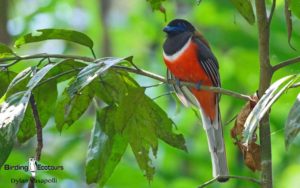
Overview
This two-week set-departure tour takes in the best of southern Indian birding and gives one access to nearly all of the Western Ghats endemics. Beginning in Bangalore the tour gradually moves southward, first to Mysore and the excellent Mudumalai area, and, following some time here, to the high-elevation town of Ooty, where a number of prized endemics await in the Nilgiri Mountains. Continuing on our southward trajectory we move across the Palghat Gap into the Anaimalai Hills to the south, which have their own suite of endemics, and we focus our time on birding around Topslip, Chinnar Wildlife Sanctuary, and the town of Munnar. The tour then progresses to the Kerala coast, where our remaining days are spent birding arguably the best birding area in southern India, Thattekad Bird Sanctuary, before the tour comes to an end in Kochi.
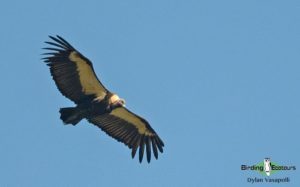
This tour would see a small group joining, with only two participants, Danny and Ira. The tour went smoothly, with little interruptions from the weather; however, the Pongal festival did prevent us from gaining entry into several areas, although fortunately in the end this didn’t cost us any particular bird species. The birding was extremely successful, and we did very well throughout the tour, finding almost all of the possible Western Ghats endemics and our targets generally, as evidenced by our commendable trip list, totaling over 270 species. Some of the highlights included the likes of Painted Bush Quail, Red Spurfowl, Nilgiri Wood Pigeon, Great Eared Nightjar, Sri Lanka Frogmouth, Sri Lanka Bay Owl, Indian Pitta, Malabar Barbet, White-bellied Treepie, Malabar Trogon, White-bellied Minivet, Black-and-orange and Nilgiri Flycatchers, Indian Blue, White-bellied Blue, and Nilgiri Blue Robins, Nilgiri Thrush, Nilgiri and Palani Laughingthrushes, Nilgiri Pipit, and many more. Seeing a large flock of some 50+ of both the Critically Endangered (IUCN) Indian and White-rumped Vultures was a major privilege and one of the ultimate highlights, as was our great run on various nocturnal birds, noting all of the possible nightjars and almost all of the possible owls.
Mammals weren’t to be forgotten, and we found the bulk of the expected species, which included Chital (Spotted Deer), Sambar, Bonnet Macaque, and Nilgiri Langur, with one of the highlights being a few separate sightings of Asian Elephants. Species lists can be found at the end of this report.
Detailed Report
Day 1, January 12, 2020. Arrival in Bangalore and transfer to Mysore, birding en-route
Danny arrived yesterday evening, while Ira had clocked in earlier in the morning, and at 6 a.m. we had all convened at our hotel and were loaded up in the car, ready to begin. It took a little while to negotiate the mega-city of Bangalore, but we arrived at our first birding site, the Ramanagara Ramdevara Betta Vulture Sanctuary, in good time. We immediately set off to a good vantage point to wait for the vultures (Indian and Egyptian Vultures – which are the major targets here) to begin moving about. It was still a little hazy in the early stages, and not much was moving, but a patient vigil eventually began to pay off as birds started becoming active. As if on cue two Egyptian Vultures came into view and spent a short while flying around just above us, while a number of other raptors were also visible – Black, Brahminy, Black-winged Kites, Besra, Oriental Honey Buzzard, and Booted Eagle were all noted, along with two Woolly-necked Storks. Despite our patience we were to luck out with the Indian Vulture, though. While waiting we enjoyed many other species in the surrounding area, top of which was the scarce and localized Yellow-throated Bulbul, which showed well in the end, along with Laughing and Spotted Doves, our first individual of the endemic White-cheeked Barbet, Indian Golden Oriole, Common Woodshrike, Long-tailed Shrike, Jerdon’s Bush Lark, Ashy Prinia, Dusky Crag Martin, Indian Robin, Tickell’s Blue Flycatcher, Purple-rumped and Purple Sunbirds, and an assortment of small seedeaters including Red Avadavat, Indian Silverbill, and Scaly-breasted Munia. After this great start we continued toward the Ranganathittu Bird Sanctuary, where we undertook a boat ride on the Kavery River to see all the nesting waterbirds. Boat rides are usually always excellent, and this one was certainly no different, giving us excellent looks and photo opportunities at all the various species present. These included Great Stone-curlew (Thick-knee), Red-wattled Lapwing, Asian Openbill, Painted Stork, Oriental Darter, Indian and Little Cormorants, Spot-billed Pelican, Purple and Grey Herons, and Black-crowned Night Heron, Great, Little, and Intermediate Egrets, Black-headed and Red-naped Ibises, Eurasian Spoonbill, and White-throated Kingfisher. A number of Muggers (Marsh Crocodiles) were also in evidence along the river. The surrounding scrub and bushes held a few other species, which included Indian Grey Hornbill, Common Iora, White-spotted (Spot-breasted) Fantail, Cinerous Tit, Tickell’s Blue Flycatcher, and Pale-billed Flowerpecker.
We had a late lunch before checking into our hotel in Mysore, where we relaxed for a short while before venturing out once again for the remainder of the day. We called in at the nearby Kukkarahalli Lake, where we birded parts of this large dam’s shoreline. There were a number of similar waterbirds to those we had seen at Ranganathittu earlier in the day, nesting here as well (albeit much more distantly), but we also picked up a few different species such as Indian Spot-billed Duck, Greater Coucal, Grey-headed Swamphen, White-breasted Waterhen, Black-winged Stilt, Common Sandpiper, and Common Kingfisher, while the surrounding trees and scrub played host to Green and Blue-tailed Bee-eaters, Coppersmith Barbet, Rose-ringed Parakeet, Common Tailorbird, Blyth’s Reed Warbler, Jungle Myna, Tickell’s Blue Flycatcher, and Purple-rumped Sunbird. We ended a great first day with a wonderful meal.
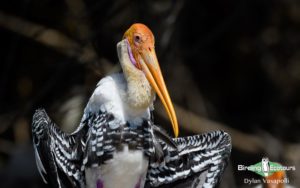
Day 2, January 13, 2020. Transfer from Mysore to Masinagudi, birding en-route.
We had a light travel day, transiting to Masinagudi in the Mudumalai Tiger Reserve area, which plays host to a number of southern Indian specialties. Following breakfast we checked out and began the drive to Masinagudi, where we eventually arrived for lunch. We had a number of stops along the way, which included a few dams and some dry roadside scrub and fields, which produced a fine array of species. The top birds seen along the way were a small flock of Bar-headed Geese, Woolly-necked Stork, Asian Openbill, Spot-billed Pelican, Red-naped and Glossy Ibises, Short-toed Snake Eagle, Booted Eagle, Indian Spotted Eagle, Shikra, Besra, Green Bee-eater, Indian Golden Oriole, Long-tailed Shrike, Ashy-crowned Sparrow-Lark, Jerdon’s Bush Lark, Pied Bush Chat, Booted Warbler, Yellow-billed Babbler, and Red Avadavat among many others. Following our arrival and lunch at our stunning lodge we had a brief siesta before venturing out on an afternoon walk around the property and the nearby vicinity. Although afternoon birding can sometimes be a bit on the slower side, we were fortunately privy to an action-packed afternoon, filled with many birds and some glorious sightings. We began things with the likes of Orange Minivet, Bar-winged Flycatcher-shrike, and Greenish Warbler before we added a whole suite of new woodpeckers in quick succession, Rufous Woodpecker, Greater and Black-rumped Flamebacks, Lesser Yellownape, and Brown-capped Pygmy Woodpecker, followed by a suite of new Drongos, namely Bronzed, Ashy, the spectacular Greater Racket-tailed, and White-bellied, all also in a rapid sequence. We spent a while admiring some of the glorious Plum-headed Parakeets and picked up a few other species such as Bay-backed Shrike, Jungle Babbler, White-browed Bulbul, Golden-fronted Leafbird, Grey Wagtail, Brahminy Starling, and Common Rosefinch among others, before ending the day in a blaze of glory, finding a stunning Changeable Hawk-Eagle that perched for ages, giving us excellent views, along with a pair of the sought Indian Nuthatches. We enjoyed our first Chital (Spotted Deer) along with Sambar, the huge Indian (Malabar) Giant Squirrel, our first of many Bonnet Macaques, the large Black-footed Gray Langur, Wild Boar, and Indian Grey Mongoose on the mammalian side. Following a great day we retired to a wonderful meal, following which we took a brief night walk, which produced a stunning and confiding Brown Fish Owl! We settled in for the evening, high with anticipation for what the following day would hold.
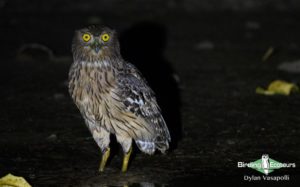
Day 3, January 14, 2020. Birding Masinagudi and surroundings
We had a full day at our disposal to bird the diverse area around Masinagudi and set off into the nearby dry-scrub forests, where we’d begin the day. We attempted to track down the localized and rare White-bellied Minivet, but were somewhat hampered by unusual thick fog, which kept the visibility down and made this a tall order. We spent a long while working all the main haunts for this species, but sadly came up empty-handed, although we did have a wide array of other species to keep us entertained during our search. These included our first Indian Peafowl, Grey Francolin, the regional endemic Grey Junglefowl, Asian Koel, Crested Treeswift, White-cheeked Barbet, Small Minivet, Black-headed Cuckooshrike, White-browed Fantail, Brown and Bay-backed Shrikes, Grey-breasted Prinia, White-browed Bulbul, Yellow-eyed Babbler, Indian White-eye, Yellow-billed Babbler, and Chestnut-tailed Starling among others. We called a halt to the minivet search and instead turned our efforts to Spot-bellied Eagle-Owl, which was supposed to be on a nest in the area. We set off on a short walk to the nesting area and soon afterwards were reveling in views of this absolutely majestic owl, perched on its nest in a hole in a tree. Having had our fill of the owl we turned our attention to some of the other birds in the area and picked up many more exciting species, including Yellow-footed Green Pigeon, Spotted Owlet, our first endemic Blue-winged (Malabar) Parakeet, Large Cuckooshrike, Bar-winged Flycatcher-shrike, Indian Scimitar Babbler, Puff-throated Babbler, and Yellow-throated Sparrow. With smiles all around we decided to give the White-bellied Minivet another try, and sure enough we struck gold when we picked up a pair perched quietly low to the ground, right next to the road. We had glorious views of this difficult bird before continuing onward and picking up a large number of vultures in the sky. We headed to an area where we could get out of the car, and working through the large flock showed the bulk to be Indian Vultures, but there were a few White-rumped Vultures in between. It was a real privilege to see these Critically Endangered (IUCN) birds. A soaring Indian Spotted Eagle was the last bird of note we found before calling it a morning, and heading back to our lodge.
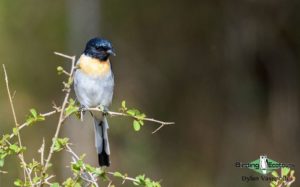
Having been cooped up in a car for most of the morning we opted to take a short walk around the lodge grounds to stretch the legs, and, although it was on the quiet side, we did well to pick up many of the same species we had seen yesterday afternoon, along with a stunning low-flying Black Eagle. We took a rest over the hottest part of the day and headed out later in the afternoon to some more open habitats, where we tried for a few of our outstanding targets. First up was Malabar Lark, and we found an individual with minimal effort, which showed well, and present in the same area were Yellow-wattled Lapwing, Blyth’s Reed and Booted Warblers, Yellow-eyed Babbler, Indian Silverbill, Scaly-breasted Munia, and several Paddyfield Pipits. We headed to another area to search for White-naped Woodpecker, but despite working the area extensively, the closest we came was hearing a distant bird call for a bit. However, one of the surprises of the day came while we were trying for the woodpecker, when an Indian Pitta hopped to the edge of the road right in front us. Unfortunately, only a few of us managed to see it before it scurried off back into the thick brush, never to be seen again. We didn’t have to wait long, however, as we picked up another individual perched quietly in the open at the edge of some thick brush, which showed well for all of us. Any day is a good day with a pitta in it! We had a quick break for some coffee and cookies before loading up again and heading off, this time on a night drive. We spent a long while working various areas, and our time was rewarded with stunning, close views of Indian, Savanna, and Jungle Nightjars, while Jerdon’s Nightjar only showed briefly and Oriental Scops Owl was only heard. On the mammalian side vast numbers of Indian Hares kept us company, but, try as we might, we just couldn’t find anything else except a few Indian Chameleons. We eventually called it a day and retired for a late dinner following a good and successful day out in the field.
Day 4, January 15, 2020. Birding Masinagudi and transfer to Ooty
We had a short transfer to the old colonial hill station of Ooty and spent our morning trying to clean up on some of the species we had missed yesterday – notably White-naped Woodpecker and Jungle Bush Quail. We had woken to another morning of dense fog, which fortunately cleared much earlier that yesterday and didn’t hamper us too much as we set about tracking down our targets. It was a fairly difficult start, not having any luck, but we transferred to another area and immediately picked up some vocal White-naped Woodpeckers. But we had to suffer through a few tense moments as we only picked up the birds in flight as they moved about almost continuously, but they soon settled down, and we enjoyed lengthy scope studies of these scarce woodpeckers, with a few of the similar Black-rumped Flameback present nearby, allowing for a great comparison. Jungle Bush Quail was proving difficult to find, and we had all but given up, having searched many fields and open areas, when we arrived at our last field in a village and somehow struck gold, first picking up on some calling birds and then seeing a group of them scuttling between bushes. A few local dogs were around, noticed the birds, charged right into the bushes, and flushed a fairly large flock (of around 12 birds) from the brush – we had good flight views rather fortuitously. During our early-morning birding we also picked up a number of other birds, some of which included Yellow-footed Green Pigeon, Yellow-wattled Lapwing, Crested Honey Buzzard, Plum-headed and Blue-winged (Malabar) Parakeets, White-browed Fantail, Bay-backed Shrike, Jerdon’s Bush Lark, Booted Warbler, Indian Nuthatch, Pale-billed Flowerpecker, and Jerdon’s Leafbird. We eventually called in for breakfast, after which we gathered our things, checked out of our comfortable lodge, and pressed on to Ooty.
We wound our way upward through 36-odd switchbacks and soon found ourselves in this high-altitude town and checked into our grand hotel before taking a break. Later we headed out for the afternoon and spent it birding various sites around Ooty. We did extremely well and had our main target, Nilgiri Blue Robin, in the bag at our first stop. It took a little while and some patience, but after having had only a few glimpses we were rewarded with good views of this skulking and highly localized bird. Black-and-orange Flycatcher was less cooperative and frustrated us throughout the afternoon, remaining a heard-only bird. The forested areas were relatively quiet, but the few birds we saw included White-spotted Fantail, Grey-headed Canary-flycatcher, Greenish Warbler, Nilgiri Flowerpecker, and Common Rosefinch. Then a dam livened things up with Garganey, Northern Shoveler, Indian Spot–billed Duck, and Northern Pintail in a large raft, while Common and Green Sandpipers, White-breasted Waterhen, and White-throated Kingfisher patrolled the edges. A group of Nilgiri Langurs was seen on the mammalian side. With the sun going down we retired for the evening.
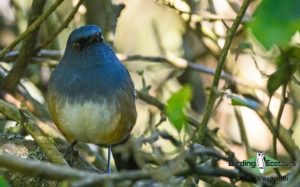
Day 5, January 16, 2020. Birding Ooty and transfer to Sethumadai
Following a good breakfast we began our morning with a visit to the nearby Doddabetta Peak, hoping to beat the crowds. This peak is the highest in the Nilgiri Mountains, rising to over 2600 meters (8530 feet) above sea level. We enjoyed birding the area for a short while before it started to get a bit too busy, so we headed farther down the mountain to some quieter areas. We did extremely well this morning and on our birding sites enjoyed the likes of Nilgiri Wood Pigeon, Hill Swallow, Square-tailed Bulbul, Tickell’s Leaf Warbler, Nilgiri Laughingthrush, Velvet-fronted Nuthatch, and both the endemic Nilgiri and Black-and-orange Flycatchers, among others. We then transferred to Kotagiri, where we tried to get into one of the sholas (patches of stunted tropical montane forest), but due to the ongoing Pongal festival this area was unfortunately closed. So we continued birding in some of the outskirts of the town. The area was a bit on the quiet side, as the time was approaching midday, but we did find species such as Grey Junglefowl, White-spotted Fantail, Indian Scimitar Babbler, and Nilgiri Flowerpecker, along with flybys from Black and Booted Eagles and Shikra, while Tytler’s Leaf Warbler frustrated us by calling incessantly from a tree a short way up the slope from us, but despite our best efforts it remained unseen. We eventually left the highlands and made our way to the lowlands, where we crossed the Palghat Gap and completed our long journey to the Sethumadai area, where we arrived in the late afternoon, eagerly looking forward to exploring the Topslip area the following day. A walk around the lodge after checking in was very quiet, but we did enjoy a small family of Spotted Owlets.
Day 6, January 17, 2020. Birding Parambikulam Tiger Reserve
Following an early breakfast we set off to Topslip in the Anamalai Tiger Reserve, where we planned to spend the morning birding. A brief wait at the entrance gate while checking in gave us a family of Large Grey Babblers, along with Common Hawk-Cuckoo, Plain Prinia, and Loten’s Sunbird. Before long we were on our way, but sadly, on arrival at Topslip, we learned what they had failed to tell us at the gate, namely that due to the ongoing Pongal festival all park activities were suspended for the day, meaning that we couldn’t walk around on the trails. We headed over to the nearby Parambikulam Tiger Reserve (which is effectively the same reserve, except just across the border in Kerala rather than in Tamil Nadu) to try our luck, but since everyone had been turned away from Anamalai and had gone to Parambikulam there were no guides available for any activities. We were resigned to birding from the car along the public access road, much to our dismay, but we made the most of the situation and very slowly drove around, stopping regularly. Our efforts were somewhat rewarded, and we enjoyed a wide array of species seen from the car, which far exceeded what we had expected to see. We did well, finding a number of Western Ghats endemics, such as Grey-fronted Green Pigeon, Malabar Barbet, Malabar Grey Hornbill, Flame-throated and Yellow-browed Bulbuls, Rufous Babbler, and Malabar Whistling Thrush. In addition to these specials we also saw a number of other species like Indian Swiftlet, Black Eagle, Crested Goshawk, Brown-headed Barbet, Plum-headed and Blue-winged Parakeets, Ashy Woodswallow, Bronzed and Greater Racket-tailed Drongos, Brown-breasted Flycatcher, and Jerdon’s Leafbird. Satisfied with our efforts we returned to our lodge for lunch and some rest before heading out later in the afternoon to some nearby areas. Although it was still quite hot and humid there was quite a bit of bird activity, and we did well while exploring the woods along some of the canals running through the area. We picked up Common Emerald Dove, Asian Koel, Crested Serpent Eagle, Chestnut-headed Bee-eater, Black-rumped Flameback, Indian Golden and Black-hooded Orioles, more Ashy Woodswallows, Common Woodshrike, Indian Paradise Flycatcher, White-browed Bulbul, Chestnut-tailed Starling, Pale-billed and Nilgiri Flowerpeckers, Loten’s Sunbird, and Grey Wagtail before calling it a day. Following dinner we set out on a brief owling stint and were eventually rewarded with excellent views of a close Indian Scops Owl and a vocal pair of Mottled Wood Owls – a great way to end the day!
Day 7, January 18, 2020. Transfer to Munnar, birding Chinnar Wildlife Sanctuary en-route
We were out early this morning, still smiling from our excellent end to the previous day, and made good progress to our first birding site, the Chinnar Wildlife Sanctuary. We had a short wait before they opened, and then immediately set off on a walk through some of the drier, acacia-dominated sections of the sanctuary with some time along the river as well. It was an overcast morning, and the birdlife was absolutely brimming with activity. Over the course of our two-odd-hour walk we recorded over 80 species, showing the great diversity of this area. The open, scrubby areas produced Asian Koel, a brief Grey-bellied Cuckoo that left us wanting more, great looks at the handsome Crested Treeswift, perched Crested Honey Buzzard and Changeable Hawk-Eagle, Chestnut-headed Bee-eater, Brown-headed Barbet, Yellow-crowned Woodpecker at long last, numbers of Small Minivets, Bar-winged Flycatcher-shrike, Bay-backed Shrike, Jungle Prinia, White-browed Bulbul, Tawny-bellied Babbler, Thick-billed and Nilgiri Flowerpeckers, Jerdon’s Leafbird, White-rumped Munia, and Yellow-throated Sparrow. Banded Bay Cuckoo and Black-throated Munia eluded us, though, and had to remain heard-only. The riverine scrub didn’t exhibit as much activity, but we did well to pick up Common Kingfisher, Black-hooded Oriole, Indian Paradise Flycatcher, Large-billed Leaf Warbler, Puff-throated Babbler, Brown-breasted Flycatcher, White-rumped Shama, Tickell’s Blue Flycatcher, and Asian Fairy-bluebird. This is only a short list of some of the better species seen here, while the others were species we had seen many times on the trip already. We were able to add Tufted Gray Langur to our mammal list here as well. We slowly continued toward Munnar, and a brief roadside stop gave us calling Red Spurfowl and Malabar Woodshrike, but we had to be content with only hearing them before continuing. The road around Eravikulam National Park to Munnar was jam-packed and made for a slightly frustrating transit, as it took quite some time to negotiate around the cars and busses all parked on the roadside. Following a much-needed lunch we checked into our glorious lodge near Munnar and set out to explore the surrounding area for the remainder of the day. The small patches of forest that line the area were brimming with birds, much like in the morning, and we made slow progress just because there were too many birds to look at. A wonderful male Indian Blue Robin started things, parading around our lodge, before we picked up the shy Dark-fronted Babbler, a species which could soon find itself on the Western Ghats endemic list, Grey-headed Canary-flycatcher, Greater Flameback, Yellow-browed and Square-tailed Bulbuls, and Black-and-orange Flycatcher. A lovely pair of adult and juvenile Bonelli’s Eagles gave us great views as they flew low overhead. Then we ended the day in a flurry of birds, finding the stunning Blue-capped Rock Thrush and Southern Hill Myna, and also enjoyed Nilgiri Wood Pigeon, Blue-tailed Bee-eater, Malabar Barbet, Blue-winged Parakeet, Golden-fronted Leafbird, and numbers of Common Rosefinches.
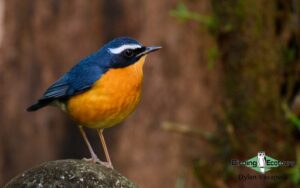
Day 8, January 19, 2020. Birding Eravikulam National Park and Pothamedu View Point
Following an early breakfast we left our hotel and made our way to the Eravikulam National Park, wary of the crowds that would show due to it being a weekend and the last day the park would be open before it would be closed for a few months due to the Nilgiri Tahr’s breeding season (which commences at this rime). We had a little while to wait before the park opened and enjoyed some brief birding around the outside, but we were soon on our way by the shuttle busses to Rajamala. As we arrived, quite early, we decided to rather walk up to the top and try out hand at the grassland species before returning to the bus station, which is often a great stakeout for many species. We did well at the top, finding the scarce Nilgiri Pipit with minimal effort and enjoying prolonged scope views before finding a confiding White-bellied Blue Robin that showed well at length. But sadly Broad-tailed Grassbird remained absent. Some of the other species seen here during our brief presence included Plain Prinia, Hill Swallow, Tickell’s Leaf Warbler, and Nilgiri and Black-and-orange Flycatchers. We then got a call that some of our other targets had been seen at the main stakeout and quickly made our way back down. We arrived only to be told that the Nilgiri Thrush that had just been seen had been chased away, but a short while later we were able to observe a stunning Nilgiri Thrush feeding quietly in the leaf litter. We had barely even had our fill of the thrush when a small family of the prized Painted Bush Quails strolled into sight, giving us excellent and prolonged views – what more could we ask for? During our time here we also picked up a number of other species, which included Indian Scimitar Babbler, Palani Laughingthrush, Indian Blackbird, another White-bellied Blue Robin, and Malabar Whistling Thrush, among others. Then we ended our time in the park and made our way back to the lodge. Just before leaving, however, we ran into a small family of Asian Elephants feeding next to the road, and we finally laid eyes on Nilgiri Tahr – the protection of which is the main objective of this reserve. Following a bit of a rest after lunch we headed out for the afternoon for a walk around the Deshadan Mountain Resort, including the Pothamedu View Point. Bird activity, as it was yesterday, was high, and we enjoyed a wealth of birds on our walk, including finding some of our missing targets such as Brown-cheeked Fulvetta, Verditer Flycatcher, Indian Black-lored Tit, and Crimson-backed Sunbird. Other species we saw were Nilgiri Wood Pigeon, Grey-fronted Green Pigeon, Malabar Barbet, Orange Minivet, Grey-headed Canary-flycatcher, Yellow-browed and Square-tailed Bulbuls, Tickell’s Leaf Warbler, Palani Laughingthrush, Velvet-fronted Nuthatch, Indian Blackbird, Indian Blue Robin, Malabar Whistling Thrush, and Blue-capped Rock Thrush, among others. At the end of a good day with a productive afternoon walk we retired for the evening.
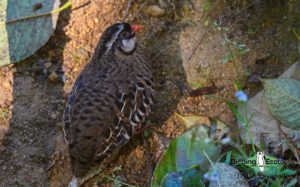
Day 9, January 20, 2020. Birding Munnar and surroundings
We had another full day at our disposal around Munnar, but woke to cool and windy conditions. Following breakfast we set off to explore some areas different from those we had visited during the past few days. But with the poor weather conditions it was a slow morning. We eventually made our way to a river, and some sunshine there seemed to help, making the birds more active. We spent some time working this area before heading to Munnar to pick up a few things. Our morning was saved, however, with an incredible show of raptors, with a pair of Black Eagles, Bonelli’s Eagle, Crested Honey Buzzard, Common Buzzard, and Shikra all moving above us at one point, while a Peregrine Falcon sat perched on a pylon nearby. Other species seen included Indian Spot-billed Duck, Little Swift, White-breasted Waterhen, Common and White-throated Kingfishers, Dusky Crag Martin, Large-billed Leaf Warbler, Indian Scimitar Babbler, Palani Laughingthrush, Nilgiri Flycatcher, Malabar Whistling Thrush, Nilgiri Flowerpecker, and Common Rosefinch. We took it easy over the midday period before resuming birding later in the afternoon with a walk above our lodge and then to the Deshadan area. It was a quiet afternoon, and we had to work hard to pick up any birds, with the windy conditions not helping much. We persisted until the early evening, picking up many of the same species that we had seen the last few days, with a few Tytler’s Leaf Warblers frustrating us by remaining out of sight, one of these sightings not being helped by a Shikra that came flying into the same tree from which the bird was calling. As soon as we arrived back at our lodge we got word that a Large-scaled Pit Viper had been seen nearby, and we headed off to see whether we could find it. It took a short while, but soon we were enjoying great looks at this handsome species, as it sat quietly on some branches near the road. We could hardly believe our luck! Following a good dinner we took a brief night walk, but the wind hampered us regarding the birds; so we did not find any owls or nightjars. But we did run into a stunning Brown Palm Civet, which gave us great and extended views.
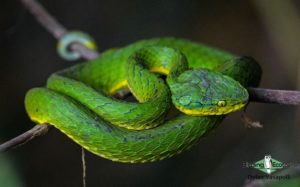
Day 10, January 21, 2020. Transfer to Thattekad and birding the surroundings
Following breakfast we checked out and began the drive to the Thattekad Bird Sanctuary area, where we would be based for the next four nights. We made good progress, arrived in the late morning, and immediately set out for a short birding walk. Our chief quarry was Streak-throated Woodpecker, and after a bit of a search we eventually found an individual that showed well. While searching for this species we also picked up a few others, such as our first Jungle Owlet, Crested Serpent Eagle, Whiskered and River Terns, a huge raft of Lesser Whistling Ducks, Rufous Treepie, Black-hooded Oriole, Oriental Dollarbird, Plum-headed Parakeet, Ashy Woodswallow, and Southern Hill Myna. What a great start to the day! We then headed over to our comfortable lodge, where we checked in and relaxed for a little while during the heat before continued birding later in the afternoon. We visited a nearby site and enjoyed a glorious afternoon’s birding, enjoying some of our most-wanted species. First was the prized Malabar Trogon, of which both male and female showed well, before a Fork-tailed Drongo-Cuckoo flew in and stole the show for a while. Malabar Grey Hornbill and a noisy Lesser Yellownape kept us distracted along with the likes of Green Imperial Pigeon, Black-headed Cuckooshrike, and Brown-breasted Flycatcher. A small group of Malabar Woodshrikes were next and showed well before we picked up the incredible White-bellied Treepie – this must be one of the best-looking Western Ghats endemics! It took a little while, but we finally got good views of one of the many Orange-headed Thrushes in the area, along with Blue-throated Blue Flycatcher. We tried our luck at finding day-roosting owls, but sadly none were home. All was not lost, however, as we picked up two tiny Gray Slender Lorises roosting in a tree – incredible! It took some special maneuvering, but everyone eventually was able to enjoy good looks at this scarce nocturnal mammal – during the day! Another fabulous sighting! With the light fading we moved to a nearby open area, where we tried for night birds, and right on cue we picked up a vocal Great Eared Nightjar. Within no time we had spotted the bird, and enjoyed both perched, and flight views of this huge nightjar! Next was Jerdon’s Nightjar; it took a little while to track down one of the calling individuals, but we too enjoyed excellent views at this nightjar, making up for somewhat poor views earlier during the trip. Then we called it a day and settled in for the evening after another good day in the field.
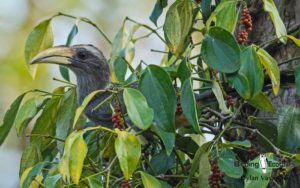
Day 11, January 22. Full day birding in and around Thattekad
Due to an audit of the sanctuary area by authorities (which meant no access for the public) we had to adapt our plans for the day and spend it outside the sanctuary area itself. We started the day at a similar area to where we had been the previous afternoon, and while we enjoyed some good birding it was definitely a morning on the slower side. We tried again for roosting owls in the area and even got close, having fleeting looks at a Brown Wood Owl as it flew off, while the resident Brown Hawk-Owl showed exceptionally well, much to our pleasure. While working the area we also picked up Grey Junglefowl, Grey-fronted Green Pigeon, the strange Heart-spotted Woodpecker, Streak-throated Woodpecker, Greater Flameback, Malabar Woodshrike, Bronzed Drongo, the stunning White-bellied Treepie (which allowed much better views than the one we had seen previous day), Malabar Starling, Southern Hill Myna, Orange-headed Thrush, Asian Brown Flycatcher, Blue-throated Blue Flycatcher, and Asian Fairy-bluebird. A midday walk around our lodge provided a few others, such as Asian Openbill, Purple Heron, a number of other egrets, Common and White-throated Kingfishers, a large flock of Chestnut-headed Bee-eaters, and Green Warbler. Again we took a break during the heat and headed out later in the day for our afternoon birding. We were sadly privy to an exceptionally slow afternoon, as it sometimes goes, with next to no birds calling and hardly any activity in general while we were working the area very hard. We did manage to see a few birds, though, which included Green Imperial Pigeon, Malabar Grey Hornbill, Blue-winged Parakeet, White-bellied Treepie, and Golden-fronted Leafbird. A good dinner followed after a hard day’s toil.
Day 12, January 23, 2020. Full day birding in and around Thattekad
Following our tough day yesterday we went into the morning with a bit more optimism, and fortunately weren’t disappointed – we had an excellent morning’s birding, filled with a number of our outstanding targets. Our first stop was a vigil over a river for Black Baza, and after a patient wait we found three birds perched on some trees, giving good scope views! A surprise Black-naped Oriole was another highlight here before we searched through a huge flock of Indian Swiftlets that produced a few of the tricky White-rumped Spinetails among them, which we saw a few other times during the day as well. We then headed into the Urulanthanni area, where we spent the rest of the morning, slowly exploring the network of trails and roads that runs through the area. The birds never seemed to let up, starting with a large White-bellied Woodpecker, which showed just after we had stepped out of the car. A pair of the prized Sri Lanka Frogmouth was next and gave us splendid, open views, showcasing their comical shuffling, before we finally connected with the endemic White-bellied Blue Flycatcher. We spent a long time searching for the near-mythical Sri Lanka Bay Owl, but sadly returned empty-handed. But our efforts weren’t for naught as we enjoyed a great many other birds, such as Green Imperial Pigeon, Grey-fronted Green Pigeon, Crested Honey Buzzard, Brown Fish Owl, stunning Malabar Trogons, Heart-spotted Woodpecker, Greater Flameback, Lesser Yellownape, Malabar Woodshrike, Black-naped Monarch, Flame-throated Bulbul, Dark-fronted Babbler, Malabar Starling, Rusty-tailed Flycatcher, Crimson-backed Sunbird, Little Spiderhunter, and Asian Fairy-bluebird. We took our customary break over the sweltering midday period and resumed birding in the afternoon, with our efforts focused on two species, both of which had given us a bit of a run-around recently, Grey-headed Bulbul and Red Spurfowl. The prime area for the bulbul had seen a recent influx of Asian Elephants into the area, and the forest department weren’t allowing many/any folks in, but we were able to get ourselves in for a quick go. What a move it proved, as a short way down the trail we finally found a Grey-headed Bulbul calling, and after a patient wait we had views of the skulking bulbul as it flitted about, perching occasionally in its bamboo thickets. Red Spurfowl would prove trickier, and it took the rest of the afternoon to connect with it, trying a number of sites, and eventually getting tipped off by another birding group of some birds feeding nearby – we headed to the area, and fortunately a pair were still around and we reveled in finally laying eyes on this species. Other species seen during our afternoon session included Common Hawk-Cuckoo, River Tern, Blue-tailed and Chestnut-headed Bee-eaters, far better looks at Black-naped Oriole, Dusky Crag Martin, and Flame-throated Bulbul, among others. We settled in for the evening and enjoyed a wonderful dinner after another good day in the field.
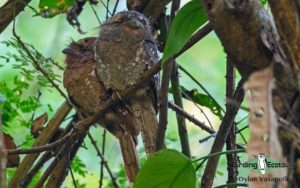
Day 13, January 24, 2020. Full day birding in and around Thattekad
Today was our last full day birding the area, and we still had a few targets to find. We started the day in Urulanthanni again. A few stops en-route eventually provided Stork-billed Kingfisher, which had somehow been missing from the trip until now, and we enjoyed further views of River Tern, Great Cormorant, Crested Goshawk, and Ashy Woodswallow as well. We then started walking, following a similar route to yesterday, and almost immediately found the massive Blue-bearded Bee-eater, perched in the open, before staking out a calling Banded Bay Cuckoo. We heard the cuckoo call for a long time before it gradually came closer, and we then picked it up flying into one the nearby trees and giving us great scope looks, at long last! We then headed off to try for some of the more difficult outstanding species, such as Blue-eared Kingfisher and Sri Lanka Bay Owl, and we struck gold when word of a Sri Lanka Bay Owl reached us. We headed a short distance up the road and into the woods and soon found ourselves face to face with this glorious and highly prized owl! We spent some time admiring this rare bird, reveling in our good fortune, before leaving the bird in peace and continuing on. A stop en-route back to the lodge gave us excellent looks at White-rumped Spinetail. Other birds seen over the course of the morning included a similar array to the species we saw yesterday, such as Green Imperial Pigeon, Sri Lanka Frogmouth, Crested Serpent Eagle, Indian Scops Owl, Brown Fish Owl, Greater Flameback, Malabar Woodshrike, Flame-throated Bulbul, Crimson-backed Sunbird, and Asian Fairy-bluebird, among others. We retired for a bit of a rest over the midday period, and following lunch we were whisked away to try for Brown Wood Owl, which was roosting nearby. Sadly, the wood owls were still as skittish as before, and we had to be content with flight views, while Bronze-winged Jacana was a bonus near the road. We resumed birding a bit later in the day, but with the humidity high it was slow going with little bird activity. We tried for some of the few species that were still outstanding, but our efforts went without reward. We did, however, manage to enjoy a few great species that we had seen many times before, such as Asian Koel, Changeable Hawk-Eagle, and Malabar Grey Hornbill, among others, before we retired to our local guide’s home nearby for a quick rest and some of the local toddi (palm wine) before giving Oriental Scops Owl one more try in the evening. Right on cue at dusk we heard a few birds calling, but despite working the area for some time and getting close, with a bird calling from a line of trees in front of us, we just couldn’t lay eyes on the birds and had to call it a day. We reminisced over our last dinner on what had been an incredibly successful tour.
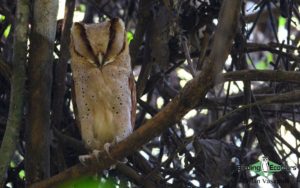
Day 14, January 25, 2020. Morning birding around Thattekad and departure
Our departure day had sadly arrived, but we still had the better part of the day available before we all departed in the late afternoon. Following an early breakfast we headed out to our stakeout over the river and settled in, awaiting what would be flying around. The activity was good, and during our vigil here we improved on our earlier views of Black Baza and found a Malabar Pied Hornbill perched distantly but offering good scope views, along with Crested Honey Buzzard, River Tern, Pied and Stork-billed Kingfishers, Heart-spotted Woodpecker, Black-naped Oriole, Large Cuckooshrike, and Malabar Starling. Mountain Imperial Pigeon frustrated us by calling from a concealed perch. We soon headed onward and called in at Urulanthanni once more for one final walk. We headed up to an open viewpoint, where we finally connected with Mountain Imperial Pigeon while also enjoying Malabar Barbet, Grey-headed and Flame-throated Bulbuls, Asian Fairy-bluebird, Malabar Trogon, and many more before having another try for Blue-eared Kingfisher. We were unsuccessful with this species, but great looks at the endemic White-bellied Blue Flycatcher were a good consolation prize! Following our good last morning we headed back to the lodge to pack our things, and following lunch we headed to the airport with a last few birding stops en route. We visited some wetlands and spent some time working them, as they were absolutely heaving with birds, dominated by large numbers of egrets, Asian Openbills, Wood Sandpipers, and Western Yellow Wagtails, and among them them we saw Little Ringed Plover, Ruff, Common Greenshank, Marsh Sandpiper, and a trio of Stints, namely Temminck’s, Little, and a rarity in form of Long-toed. All too soon our time was up, however, and we headed to the airport, where the tour concluded and we all went our separate ways.
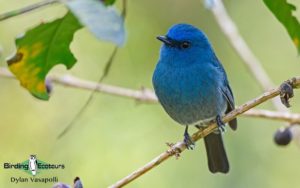
I just want to thank Danny and Ira for joining the tour and for being excellent clients that made the tour all the more enjoyable and the birding a delight! Overall we did have a successful tour, filled with far too many highlights to list, but some were finding the mythical Sri Lanka Bay Owl after a huge amount of effort and our impressive list of other owls, along with a host of difficult species such as White-bellied Minivet, Indian Pitta, Painted Bush Quail, and Nilgiri Thrush. Thanks must also go to our trusty local guide, Abilesh, whose knowledge of the area and route gave us the best chances at trying for all our targets, with nearly all of which we were successful. Looking forward to doing this again come 2021!
Please see the downloadable PDF above with the full species lists included. This is a sample trip report. Please email us ([email protected]) for more trip reports from this destination.
‘Highlights of the Western Ghata and Nilgiri tour included seeing the regional endemic bird species such as Nilgiri Blue Robin, White-bellied Blue Robin, Black-and-orange Flycatcher, Malabar Whistling Thrush, Crimson-backed Sunbird, Sri Lanka Frogmouth, Sri Lanka Bay Owl, giant squirrels and Asian Elephants. The local cuisine was also a highlight!
Dylan was friendly and professional with a good sense of humour. He knew when to be intense, when to lighten up on the birding and was always cordial. Dylan was never demeaning when answering questions. Our local guides were excellent, especially in Thattekad and Masinagudi.’
Ira

